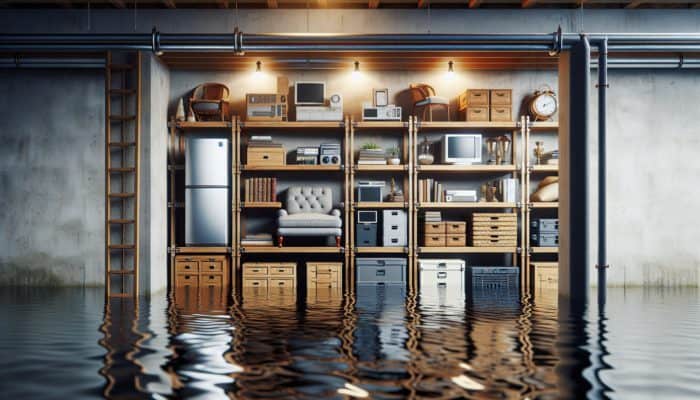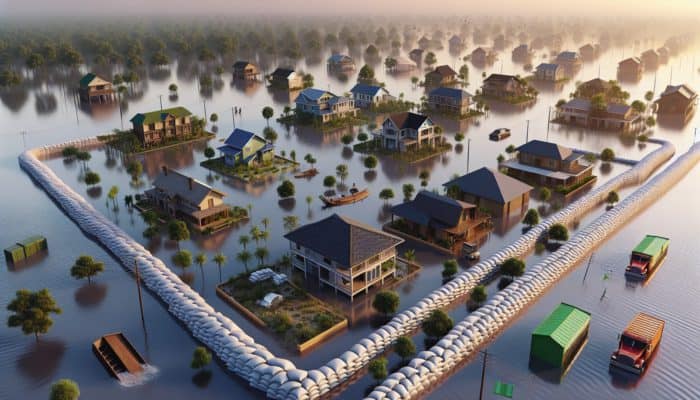Comprehensively Understanding Flood Risks for Enhanced Safety
Flood Preparation Steps: Floods are among the most catastrophic natural disasters, affecting millions of people worldwide each year. A comprehensive understanding of flood risks is essential for both urban and rural communities. By closely evaluating where floods are likely to occur and assessing their potential severity, residents can take proactive measures to reduce damage and ensure safety. The initial step in effective flood preparedness involves identifying potential flood zones, enabling individuals to make informed decisions about their safety and property.
Strategically Identifying Potential Flood Zones in Your Area

Recognising areas that are particularly vulnerable to flooding is an essential aspect of effective flood preparation steps. Historical data serves as a critical tool in revealing patterns of past flood incidents, thereby assisting in pinpointing regions that consistently experience flooding. Various factors contribute to a location's flood risk, including geographical features, soil types, and human-made structures, making this analysis imperative. For instance, communities situated near rivers, lakes, or coastal areas generally face heightened flood risks due to their proximity to significant water sources.
Local topography has a significant influence on identifying flood-prone areas. Regions that are low-lying or have inadequate drainage systems are particularly susceptible to flooding. By analysing past weather events, such as hurricanes or intense rainfall, individuals can gain insights into the likelihood of upcoming floods. Furthermore, flood maps serve as invaluable resources, illustrating high-risk zones and helping residents make informed decisions about their safety and preparedness.
In many parts of the world, community engagement is crucial in identifying local flood risks. Organising workshops and town hall meetings can effectively inform residents about historical flood incidents and evolving risks stemming from climate change. By collaborating as a community, individuals can enhance their preparedness for potential flood events, fostering a culture of resilience and safety.
Thoroughly Evaluating Flood Risk Levels for Informed Decisions
Determining the severity of flood risks necessitates a detailed analysis of historical data and the utilisation of advanced flood mapping technologies. Flood risk levels can be categorised based on their frequency and potential impact on the community. For example, a 100-year flood refers to a flood event that has a 1% chance of occurring in any given year; however, the onset of climate change has led to increasingly intense storms, rendering such categorizations less reliable over time.
Using flood maps enables homeowners and renters to understand their specific vulnerabilities effectively. Many governments and agencies provide these maps, showcasing areas at high risk for flooding. Moreover, advanced modelling techniques allow scientists to predict flood patterns based on various scenarios, further aiding in the evaluation of flood risk levels. This comprehensive understanding is crucial for communities to adapt and respond effectively to potential flooding.
Community members must also consider the socio-economic dimensions of flood risks. Certain neighbourhoods may be more vulnerable due to factors such as poverty and limited access to resources. By understanding these elements, communities can ensure more equitable preparations and responses, guaranteeing that all residents receive the necessary support during times of crisis, thus fostering resilience among all societal segments.
Vigilantly Monitoring Weather Forecasts to Stay Prepared
Staying informed about weather forecasts is paramount for effective flood preparedness. Modern technology offers real-time updates and alerts regarding potential flooding events, enabling residents to take timely action before it's too late. Meteorological agencies worldwide offer numerous channels for accessing weather information, ranging from mobile applications to social media updates, ensuring that individuals remain informed.
Residents should take the initiative to familiarise themselves with local weather patterns and seasonal trends. For instance, regions prone to monsoons may experience predictable flooding during specific months, while others may be caught off guard by unexpected heavy rainfall. By understanding these patterns, individuals can enhance their preparedness for impending flood threats and take the necessary precautions to protect themselves and their property.
Establishing a robust communication network within communities is also essential. Neighbours can share weather updates and early warnings, promoting a culture of preparedness and collaboration. Additionally, emergency services and local governments can enhance this network by implementing alert systems that notify residents about severe weather forecasts that may lead to flooding, thereby fostering a proactive approach to flood risk management.
Assessing Infrastructure Vulnerability to Strengthen Community Resilience

The resilience of local infrastructure plays a pivotal role in mitigating the impacts of flooding. Conducting thorough evaluations of bridges, drainage systems, and levees helps determine whether these structures can withstand flood events. Communities must understand the strengths and weaknesses of their infrastructure, as well-maintained systems can significantly reduce flood risks and enhance safety for residents.
Regular inspections and maintenance of drainage systems are critical. Clogged drains can exacerbate flooding, resulting in severe property damage and posing safety hazards. Moreover, local governments must prioritise investments in enhancing infrastructure to adapt to increasing rainfall and emerging flood risks attributed to climate change. By proactively addressing these vulnerabilities, communities can better prepare for future flood events.
In many regions, embracing innovative solutions can bolster infrastructure resilience. For example, implementing green infrastructure, such as permeable pavements and rain gardens, can effectively absorb excess water, reducing runoff and flooding. Communities that prioritise sustainable practices not only enhance their flood resilience but also contribute positively to overall environmental health, creating a win-win situation for both residents and nature.
Implementing Effective Early Warning Systems for Timely Alerts
Robust early warning systems are essential components of successful flood preparedness. These systems can enhance community awareness and prompt timely evacuations, ultimately saving lives during critical situations. By harnessing technology, such as weather satellites and advanced modelling systems, communities can receive alerts about imminent flooding, allowing for proactive measures to be taken.
Collaboration between government agencies, meteorological organisations, and local authorities is vital for the effective implementation of these systems. Engaging the community in preparedness drills can familiarise residents with the alerts and the appropriate actions to take when notifications are received. This practice fosters a sense of readiness and confidence within the community.
Communities must ensure early warning systems are accessible to all, including individuals with disabilities or those who face language barriers. By fostering inclusivity in preparedness efforts, towns can guarantee that every resident is informed and ready to act when faced with flood threats, thus enhancing overall community resilience.
Proactively Preparing Your Home for Flood Risks
Preparing your home for potential flooding represents a proactive measure that can significantly mitigate damage and protect your property. Taking specific actions can safeguard your belongings and ensure your safety during flood events. The following steps will guide homeowners in effectively protecting their properties against floods, enabling them to navigate flood risks with confidence.
Elevating Important Items to Minimise Flood Damage

Raising furniture and valuables to higher levels is one of the most effective steps a homeowner can take to prepare for a flood. Water can inflict irreparable damage upon numerous household items, including electronics, appliances, and personal belongings. Elevation serves to protect these items and significantly reduces the overall risk of loss in the event of flooding.
Consider creating designated storage areas on higher floors or utilising raised platforms for important items. This could involve using shelves, cabinets, or even platforms above anticipated flood levels. For example, in flood-prone areas, garages and basements are often particularly vulnerable. Elevating tools and equipment stored in these areas can make a substantial difference in safeguarding your possessions and ensuring their longevity.
Furthermore, it is prudent to consider the materials used in your home furnishings. Choosing flood-resistant materials can also play a critical role in minimising damage. For instance, avoid using pressed wood or other porous materials that can absorb water and promote mould growth. Instead, opt for water-resistant materials that can withstand damp conditions, thereby enhancing the overall resilience of your home against flooding.
Installing Flood Barriers for Effective Protection
Utilizing flood barriers, such as sandbags or floodgates, represents an effective method of preventing water from entering your home. These temporary solutions can create a first line of defence against rising water levels. Proper installation and positioning are crucial to maximising their effectiveness and ensuring that your property remains protected during flood events.
Sandbags can be strategically placed around doorways, windows, and other vulnerable entry points to provide additional protection. When filled correctly and stacked in a pyramid shape, they can redirect water away from your home, significantly reducing the risk of water intrusion. Flood gates offer a more permanent solution, providing robust protection against flooding and enhancing overall safety.
When deploying flood barriers, it is essential to act quickly and preemptively. Closely monitor weather forecasts and prepare your barriers ahead of an impending storm. Communities can also collaborate in implementing larger-scale barriers, pooling resources for collective protection, and enhancing overall flood resilience in the area.
Sealing Entry Points to Prevent Water Intrusion
Ensuring that entry points, such as doors and windows, are properly sealed is critical in minimising water intrusion during a flood. Gaps and cracks can allow water to seep in, causing extensive damage and increasing the risk of mould growth. Regular inspections of these areas can identify potential vulnerabilities that need to be addressed.
Utilising weather stripping and caulking is an effective method for sealing gaps around doors and windows. This not only helps to keep water out during floods but can also improve energy efficiency within your home, resulting in reduced utility costs. Additionally, consider installing flood-resistant doors and windows specifically designed to withstand flood conditions, further enhancing your home's resilience.
It is also vital to check basement entry points, as these areas are particularly susceptible to flooding. Installing sump pumps can further assist in diverting water away from your home’s foundation, protecting against potential damage and ensuring the integrity of your property.
Developing a Comprehensive Emergency Plan
Having a well-thought-out emergency plan is a cornerstone of effective flood preparedness. Every household should develop a robust strategy that outlines evacuation routes, communication methods, and practice drills. By doing so, families can ensure they are ready to respond promptly and effectively when flooding occurs, thus minimising risks and ensuring safety.
Strategically Developing Evacuation Routes for Safe Departures
Planning multiple safe evacuation routes is crucial for ensuring swift and safe departures during a flood. In many scenarios, roadways may become impassable due to rising waters, highlighting the need for alternative routes. Evaluate local maps and identify safe areas that can serve as a refuge in the event of an emergency.
When developing evacuation plans, families should consider various factors, including distance, road conditions, and accessibility. Consider how pets and individuals with special needs will affect evacuation logistics, as these factors may require specific accommodations to ensure everyone's safety.
Additionally, it is vital to communicate these routes with all family members—practice evacuation drills to familiarise everyone with the routes and the timing involved. By regularly reviewing and updating the plan, families can ensure they remain prepared, regardless of changing circumstances, and significantly enhance their overall readiness for flood events.
Establishing Effective Communication Methods
Effective communication is a cornerstone of any emergency plan. Setting up a reliable system to stay in touch with family members during a flood ensures that everyone is accounted for and can coordinate their actions effectively. Consider utilising both traditional and modern communication methods, including phone calls, texts, and social media platforms.
Establish a designated meeting place for family members to regroup if separated. This could be a neighbour's home or a local community centre, providing a haven during emergencies. Ensure that everyone knows how to reach each other and has access to emergency contact information.
In the digital age, leveraging technology can significantly enhance communication. Consider using group messaging apps or social media platforms to quickly disseminate information. Keeping these lines of communication open can greatly reduce panic and confusion during a flood event, ultimately fostering a sense of security within the family.
Regularly Practicing the Emergency Plan for Preparedness
Conducting regular drills helps ensure that all family members are familiar with the emergency plan and know how to respond in the event of an emergency. These practice sessions can build confidence and identify areas needing improvement, ensuring that the family is well-prepared for potential flood scenarios. Each drill should be comprehensive, covering all aspects of the emergency plan.
During these drills, simulate various scenarios to determine how effectively your family can respond to them. This might include unexpected flooding or limited access to certain evacuation routes, providing valuable insights into your family's readiness. By challenging your plan in different scenarios, you can better prepare for the unpredictability of actual floods.
Feedback from each drill can offer insights into potential weaknesses in your plan. Encourage open communication and gather input from all family members to make necessary updates for improvement. Regularly reviewing and practicing your emergency plan can significantly reduce stress levels during actual flood events, ensuring that everyone knows their role and responsibilities.
Assembling a Comprehensive Emergency Kit
An emergency kit is an essential component of flood preparedness. Having a well-stocked kit ready to go can make all the difference when a flood strikes. This kit should include various essential supplies to support your family for several days, ensuring that you are adequately prepared for any eventuality.
Gathering Essential Supplies for Your Emergency Kit
Creating a comprehensive emergency kit requires careful consideration of the supplies you'll need in a flood scenario. Start by including non-perishable food items, such as canned goods, dry snacks, and hydration packs. Aim for sufficient supplies to last at least three days for each family member, considering their varying dietary needs and preferences.
Water is a critical component of any emergency kit. It is advisable to store at least one gallon of water per person per day. Don't overlook the need for additional supplies for pets or other dependents, ensuring that everyone has access to clean drinking water. Keep in mind that any stored water should be rotated regularly to ensure freshness and safety.
In addition to food and water, consider including personal hygiene items as well. This may encompass toiletries, wet wipes, and hand sanitizers. Such supplies can enhance comfort and minimise health risks during extended periods of displacement, contributing to overall well-being during challenging times.
Preparing a Well-Stocked First Aid Kit
In emergencies, access to medical care can become limited. Assembling a well-stocked first aid kit is crucial for addressing minor injuries and health concerns that may arise during a flood. Essential items should include bandages, antiseptics, gauze, and medical tape, ensuring that you are prepared for a range of potential health issues.
Don't overlook prescription medications; be sure to include enough supplies to last for several days. If family members have specific health concerns, ensure those needs are met within the kit, providing peace of mind during emergencies. Consider including basic medical reference guides for handling common injuries or illnesses to further enhance your preparedness.
It's also wise to incorporate items like tweezers, scissors, and a thermometer. These tools can help address various health issues that may arise during a flood, ensuring you are adequately equipped to manage minor medical emergencies. Regularly checking and updating your first aid kit will ensure it remains effective and ready for use in times of need.
Including Important Documents in Your Emergency Kit
Protecting vital records is a frequently overlooked aspect of flood preparedness. Make copies of essential documents, such as identification cards, insurance policies, and medical records, and store them in a waterproof container to safeguard against water damage. This precaution can save time and reduce stress during recovery efforts, allowing for a smoother transition back to normalcy.
Digital storage serves as another viable option for safeguarding these documents. Consider utilising cloud storage services to ensure accessibility even if physical copies are lost or damaged. Additionally, keep backup copies of any important contacts, including doctors and insurance agents, ensuring that vital information is readily available.
Regularly reviewing and updating these documents is key to maintaining their relevance. Ensure that any changes, such as new insurance policies or significant life events, are reflected in your emergency kit. By prioritising document safety, you can streamline the recovery process following a flood, enabling a more efficient response to unforeseen circumstances.
Adding Essential Emergency Tools to Your Kit
Incorporating emergency tools into your kit can significantly enhance your preparedness during a flood. A multi-tool can provide various functionalities, from opening cans to making repairs, ensuring that you are equipped to handle a range of situations. Flashlights and batteries are essential for maintaining visibility when the power goes out, allowing for safe navigation in low-light conditions.
Including a whistle is a simple yet effective addition. This tool can signal for help in case of emergencies when loud noises might be necessary to alert rescuers. Additionally, consider packing a portable phone charger to ensure you can maintain communication during a flood, keeping you connected with loved ones and emergency services.
These tools are not only practical but can also boost morale during a stressful situation. Having access to essential supplies and devices can make navigating a flood much more manageable, providing a sense of security and preparedness in the face of uncertainty.
Ensuring Communication Devices Are in Your Emergency Kit
Communication devices are a lifeline during emergencies. A battery-powered or hand-crank radio can provide updates and alerts, even when mobile networks fail, keeping you informed about the situation. Keep extra batteries on hand to ensure your devices remain functional throughout an emergency, enabling continuous access to vital information.
Additionally, a fully charged mobile phone is crucial for staying in touch with loved ones and emergency services. Consider investing in portable chargers to keep your phone powered during extended power outages, ensuring that you can communicate effectively. Stay informed about local emergency alerts through official channels and social media, which can provide timely updates on flood conditions.
Establishing a communication plan with family and friends can help ensure everyone is accounted for during a flood. Share your emergency contact information and establish a designated check-in procedure to foster a sense of security and preparedness within your support network. This proactive approach can alleviate anxiety and enhance overall readiness during flood events.
Implementing Strategies to Protect Your Property from Flood Damage
Protecting your property from flood damage is a critical aspect of flood preparedness. By taking preventive measures, homeowners can significantly reduce the risk of costly repairs and potential property loss. The following steps outline effective strategies for safeguarding your home against flooding, enabling a proactive approach to managing flood risk.
Obtaining Comprehensive Flood Insurance for Protection
Securing flood insurance is one of the most effective ways to protect your property from flood-related losses. Many homeowners mistakenly assume that standard insurance policies adequately cover flood damage, but this is often not the case. Obtaining specialised flood insurance provides essential financial protection against such events, ensuring you are prepared for unexpected flooding.
Research the specific flood insurance options available in your area, as some regions may offer government-backed insurance programmes while private insurers might provide additional choices. Understanding the intricacies of your policy is critical to ensuring comprehensive coverage and safeguarding your financial well-being in the event of a flood.
Moreover, consider reassessing your insurance needs periodically. As property values fluctuate and risks evolve, regular policy reviews can help you avoid gaps in coverage. Staying informed about changes in your environment, such as development projects or climate trends, can help you make more informed insurance decisions, ensuring that you are adequately protected at all times.
Reinforcing Structural Integrity to Withstand Flood Waters
Strengthening your home's structural integrity is a proactive measure that can help it withstand floodwaters effectively. This may involve reinforcing walls, foundations, and windows to reduce vulnerabilities, ensuring your property is better equipped to handle potential flooding. Consulting with professionals can provide valuable insights into the most effective strategies tailored to your specific property.
Investing in flood-resistant materials during renovations can further enhance your home’s resilience. For instance, using water-resistant drywall and insulation can help mitigate the effects of flooding, protecting your property from water damage. Elevated foundations are another option to consider, as they can keep living spaces above potential flood levels, significantly reducing the risk of water intrusion.
Regular maintenance is also vital for maintaining structural integrity. Inspecting and repairing any damage promptly can help prevent larger issues down the line. By being proactive about your home's condition, you can ensure it remains a haven during flood events, providing peace of mind for you and your family.
Maintaining Clear Drainage Systems to Reduce Flood Risks
Keeping drainage systems clear is crucial for effectively mitigating flood risks. Clogged gutters and drains can lead to water buildup, increasing the likelihood of flooding on your property. Regular inspections and maintenance can help ensure that these systems function optimally, preventing potential water accumulation and ensuring optimal performance.
Consider trimming nearby tree branches and clearing debris from gutters to prevent blockages. Additionally, checking that downspouts direct water away from your home can further reduce the risk of flooding. In some cases, installing rain barrels or French drains can help manage excess water effectively, providing an additional layer of protection against flooding.
Communities can work together to organise neighbourhood clean-up days and collectively address drainage issues. This proactive approach fosters community resilience and enhances everyone's flood preparedness, ensuring that all residents are equipped to handle potential flooding.
Elevating Electrical Systems to Enhance Safety
Raising electrical systems above anticipated flood levels can safeguard your home from potential hazards. Water damage to electrical components poses significant risks, including the potential for fires and power loss during emergencies, making this a critical consideration for homeowners.
Consider having a licensed electrician assess your home’s electrical systems and recommend elevating critical components, such as circuit breakers and outlets. This is particularly important in basements or lower levels, which are more susceptible to flooding and water damage.
Investing in waterproof electrical boxes and utilizing sealed conduits can further enhance safety, ensuring that your electrical systems remain functional during flood events. Regularly inspecting these systems can help identify vulnerabilities, ensuring that your home remains safe and secure during flood emergencies.
Effectively Responding to Flood Events for Safety
When a flood event occurs, a timely response is crucial for ensuring safety and minimising damage. Knowing what actions to take can significantly affect your family's well-being and property during such critical situations. Being prepared to respond effectively can make all the difference in navigating flood challenges.
Acting Quickly and Safely During Flood Events
Swift action is essential during a flood event. Evacuating, if necessary, should always be the top priority. Communities often issue alerts when a flood event is imminent, and adhering to these advisories can save lives. Understanding your evacuation routes and having a clear plan in place, as previously discussed, is critical to this process.
Once you are safe, stay informed about the flood situation through reliable news sources and authorities. Avoid driving through flooded areas, as this can pose significant risks to you and others. If you find yourself in a dangerous situation, seek higher ground and signal for help to ensure your safety.
Remaining calm during a flood is vital. Panic can lead to poor decision-making. Encourage family members to stay focused on the plan, ensuring that everyone understands their roles and responsibilities in the event of an emergency. This collective calm can foster an environment of safety and preparedness.
Shutting Off Utilities to Prevent Hazards
Turning off electricity, gas, and water is a key safety measure during a flood. These actions can prevent hazardous situations, such as electrical fires or gas leaks, that can arise during flooding. Please familiarise yourself with the locations of all utility shut-off valves beforehand, ensuring you can access them quickly in an emergency.
If flooding is imminent, take the time to shut off these utilities before evacuating, as this can reduce risks and enhance safety. In some cases, local authorities may issue advisories to take these actions; therefore, always err on the side of caution, prioritizing safety above all else.
Once utilities are turned off, avoid reactivating them until authorities confirm that it is safe to do so. This precaution can significantly reduce risks and ensure that you are not exposed to unnecessary dangers during the recovery phase, protecting you and your family from potential hazards.
Thoroughly Documenting Damage for Recovery Efforts
After a flood, documenting any damage is crucial for filing insurance claims and facilitating recovery efforts. Taking photos and detailed notes can help create a comprehensive record of the destruction, facilitating a smoother claims process with your insurance company. This documentation can significantly streamline recovery efforts, enabling you to access necessary funds more efficiently.
Consider including timestamps and descriptions alongside photos to provide context for each item or area affected. This meticulous documentation can make a substantial difference when filing your claim and seeking restoration assistance, ensuring that you have all the necessary evidence to support your case.
In addition to documenting physical damage, keep track of any expenses incurred during the recovery process. This may include costs associated with temporary housing or repairs made to restore your home. Maintaining organised records can facilitate reimbursement and support your recovery efforts, ensuring that you are well-prepared for the challenges ahead.
Recovering After a Flood: A Step-by-Step Approach
Recovering from a flood can be a challenging and prolonged process. Understanding the necessary steps can make the transition smoother and less overwhelming for those affected and their families. By taking a systematic approach to recovery, residents can navigate the aftermath of flooding more effectively.
Assessing Damage and Ensuring Safety Before Re-entering
Before entering your home after a flood, assessing damage and ensuring safety is paramount. Look for any structural damage and be cautious of potential hazards, such as unstable walls or collapsed roofs. If there are visible dangers, it may be best to wait for professionals to assist, prioritising safety above all else.
After assessing the external structure, check for standing water inside your home. If it is safe to do so, begin the process of removing any water and debris as soon as possible. This minimises damage and prevents mould growth, which can pose serious health risks to you and your family.
Communicate with local authorities to determine any necessary safety measures or precautions to follow during the recovery process. Following their guidance can help ensure your safety as you navigate the aftermath of flooding, providing valuable support during this challenging time.
Cleaning and Sanitising Your Home After a Flood
Once it's safe to enter your home, begin the cleaning and sanitising process promptly. Remove all standing water, mud, and debris as soon as possible. This will help prevent mould growth and promote healthier living conditions for you and your family during the recovery phase.
Disinfect affected areas thoroughly to eliminate potential pathogens. Use a mixture of household bleach and water as a cleaning solution for hard surfaces, following safety guidelines during the cleaning process. Ensure proper ventilation throughout the cleaning process, as mould spores can exacerbate respiratory issues, particularly for sensitive individuals.
It’s vital to dispose of any items that cannot be salvaged, such as carpets or furniture that have absorbed water. Keeping these items can pose health risks and hinder the recovery process, so be prepared to seek assistance from local relief organisations that can help with recovery efforts and provide necessary resources.
Seeking Assistance and Resources for Recovery
Contacting relief organisations and government agencies is an essential step in the recovery process. Many communities have established support networks to assist residents impacted by floods. These organisations can provide valuable resources, including financial assistance, temporary housing, and counselling services to aid in the recovery journey.
Identify local charities or non-profits that specialise in disaster recovery. They can help connect you with resources tailored to your specific needs, ensuring that you receive the support necessary to rebuild your life after a flood. Additionally, check for government assistance programmes that can provide financial support for repair and recovery efforts, alleviating some of the burdens during this challenging time.
Remain proactive in seeking help and resources. The recovery process can be overwhelming, but numerous organisations are ready to assist you in rebuilding your life after a flood. By taking the initiative, you can access the resources and support you need to successfully navigate the challenges ahead.
Learning from Experience to Enhance Future Flood Preparedness
Reflecting on past experiences can offer invaluable insights into improving flood preparation strategies. Both communities and individuals can enhance future readiness by analysing what worked effectively and identifying areas that require improvement. This continuous learning process is essential for building resilience against future flood events.
Reviewing What Worked: Assessing Past Flood Responses
Assessing the effectiveness of your preparation and response strategies is crucial for ongoing improvement. Take the time to reflect on the specific steps taken during a flood event, identifying which actions proved effective and which strategies fell short, providing valuable lessons for the future.
Engage family members in this reflection process, as diverse perspectives can yield a comprehensive understanding of what worked well and what could be improved. Consider documenting these insights to create a living strategy that evolves with each flood experience, ensuring that you are better prepared for future challenges.
Additionally, communities should conduct after-action reviews to evaluate their collective response. Engaging local stakeholders can help identify successful strategies and areas for improvement, thereby fostering collaboration and resource sharing among residents. By working together, communities can enhance their overall resilience to future flood events and create a stronger support network.
Identifying Areas for Improvement in Flood Preparedness
Determining what could be done better next time is vital for enhancing flood preparedness. Analyze the responses during the flood; consider the challenges faced and how they could have been addressed more effectively. This reflective practice can lead to improved preparedness strategies and better outcomes in future flood events.
Feedback from family members and neighbours can provide valuable insight into areas that require adjustments. This might involve enhancing communication methods, refining evacuation routes, or reevaluating emergency kits to ensure that they meet the needs of all community members. This process of continuous improvement is key to building resilience against future challenges.
Additionally, consider how community engagement can be improved. Assess whether all residents received vital information and identify any barriers to effective communication. Identifying these gaps can help ensure everyone is better prepared for future flood events, fostering a culture of preparedness and collaboration.
Implementing Lessons Learned to Strengthen Future Strategies
Applying insights gained from past flood experiences is crucial for improving future strategies. Develop an action plan that incorporates improvements identified during the review process. This could involve updating emergency kits, refining communication methods, or enhancing community preparedness initiatives based on collective feedback and experiences.
Share your lessons learned with neighbours and local organisations to foster a culture of preparedness within the community. By working collaboratively, communities can build stronger defences against floods and encourage widespread engagement in emergency planning, ensuring that all residents are equipped to handle potential flooding.
Continually revisiting and updating your flood preparation strategies ensures that you are ready for what the future may hold. Embracing the lessons learned from past experiences empowers both individuals and communities to face challenges with confidence, fostering resilience and unity in the face of adversity.
Frequently Asked Questions About Flood Preparedness
What are the primary flood preparation steps to take?
The primary steps in flood preparation include understanding flood risks, preparing your home, creating an emergency plan, assembling an emergency kit, and protecting your property from potential flood damage.
How can I effectively identify potential flood zones in my area?
Identify potential flood zones by reviewing historical flood data, analysing local topography, and consulting flood maps provided by government agencies to understand your community's flood risk better.
What essential items should I include in my emergency kit?
Your emergency kit should consist of non-perishable food, water, medications, first aid items, important documents, and communication devices to ensure you are prepared for various scenarios during a flood.
Why is flood insurance important for homeowners?
Flood insurance is crucial because standard policies typically do not cover flood damage. It provides financial protection for your property and belongings, ensuring you can recover from flood-related losses effectively.
How do I create an effective evacuation plan for my family?
To create an effective evacuation plan, identify multiple safe routes, establish communication methods, and practice the plan regularly with all family members to ensure everyone is familiar with the procedures.
What should I do during a flood event to ensure safety?
During a flood event, act quickly and safely by evacuating if advised, shutting off utilities, and following emergency protocols provided by local authorities to minimise risks to you and your family.
How can I assess damage to my property after a flood?
Assess damage by carefully inspecting your property, documenting any destruction, and ensuring it’s safe to enter before beginning cleanup and recovery efforts to streamline the restoration process.
What are the best practices for cleaning and recovering after a flood?
After a flood, remove standing water and debris quickly, disinfect affected areas to prevent mould, and dispose of items that cannot be salvaged to promote a safe and healthy living environment.
How can communities improve flood preparedness and resilience?
Communities can enhance their flood preparedness by engaging residents in workshops, sharing flood risk information, and developing robust early warning systems to ensure that everyone is informed and ready to respond.
What are the long-term recovery steps I should follow after a flood?
Long-term recovery steps include assessing damage, seeking assistance from relief organisations, documenting losses for insurance claims, and implementing lessons learned to improve future flood preparedness strategies.
Explore our journey on X!
Emergency Family Plan: Universal Preparation Guide
Comprehensive Elements to Include in Your Family Emergency Plan Effective Communication Strategies for Emergencies Emergency Family Plan: Establishing effective communication strategies is absolutely vital for ensuring that family members remain connected and informed during emergencies. It’s crucial to have clear, reliable methods in place that everyone understands and can utilise effortlessly. This encompasses traditional communication […]
Survival Water Bottles: Essential Gear for Emergencies
Why Survival Water Bottles are Essential for Emergency Preparedness Understanding the Significance of Hydration in Crisis Situations Survival Water Bottles: Maintaining hydration is vital for ensuring optimal bodily functions during emergencies. In scenarios where access to clean water is limited, sustaining proper hydration is crucial in preventing health complications associated with dehydration, which can include […]
Water Safety in Crises: Essential Tips and Strategies
The Crucial Role of Water Safety During Crises Identifying Water-Related Risks in Crisis Situations Water Safety in Crises: Crises arising from natural disasters, such as floods and hurricanes, or from human-induced events, like conflicts, frequently heighten water-related risks. During these challenging times, the security and quality of water supplies can be severely compromised, leading to […]
Survival Radio Options: Essential Gear for Emergencies
Comprehensive Guide to Different Types of Survival Radios Portable Handheld Radios for Emergency Situations Survival Radio Options: Portable handheld radios are essential components of any effective survival strategy, providing unparalleled portability and user-friendliness during emergencies. These devices are specifically engineered to be lightweight, making them perfect for activities like hiking, camping, or preparing for unforeseen […]






